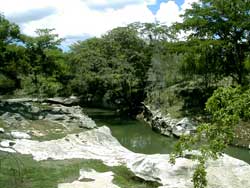By Lino Luben Perez / ACN.
 The Haitian, Cuban and Dominican Environment Ministers agreed in 2007 to create a Biological Corridor in the Caribbean to face climate change, which is affecting the whole region, but mostly the Haitian nation.
The Haitian, Cuban and Dominican Environment Ministers agreed in 2007 to create a Biological Corridor in the Caribbean to face climate change, which is affecting the whole region, but mostly the Haitian nation. Representatives from these three countries met once again in Port-au-Prince two years later to carry on with this project, and to finalize the plan of action presented in the Copenhagen Climate Summit, held in the Danish capital, in December of that same year.
From the social viewpoint, the parts agreed in that the establishment of a coherent environmental policy brings about improvements in the living conditions of a territory.
In fact, due to the socioeconomic vulnerability that has been spread for a long span, the Haitian population cut down the woods and used lumber, among other things, as fuel.
Some people believe that this Corridor would look like European green and blue strips that allow differentiating among vegetable areas or rivers that should be preserved.
These spaces lead to continuity among areas, which are characterized by their exceptional biodiversity; or are settled along migration areas of several species.
Unquestionably, the Caribbean environment safeguards immeasurable richness.
Every island in the area, whether large or small, shows significant levels of endemism and therefore, they provide unique habitats for some species.
If this initiative succeeds, which aims at protecting terrestrial and marine ecosystems, the three islands would benefit from this common environmental policy.
Specialists affirm that its implementation is vital considering proximity, which favors the spreading of pollution, the environmental regressions, and the foreseeable consequences of climate change in their ecosystems.
In addition to the protection of the natural environment, this project could take a long stance depending on financial resources.
This Corridor would result in the creation of jobs, as agents for the protection of means and research bodies.
The main tasks of this initiative comprise reforestation, management of the main ecosystems in coastal areas, quick ecologic assessments, elements for the creation of reserves of the biosphere in Haiti, and studies on exotic invading species in La Hispanola.
Yet, as for the time being, there are no concrete actions as to the protection of marine mammals and the creation or better management of protected marine areas.
The last meeting on this issue took place in April, 2010, and the physical location of the program and the selection and modalities for hiring administrative personnel are still under debate.
Nowadays, 15 % of the territories in the Dominican Republic and in Cuba are protected; whereas, in Haiti only less than two per cent is under protection.
No comments:
Post a Comment